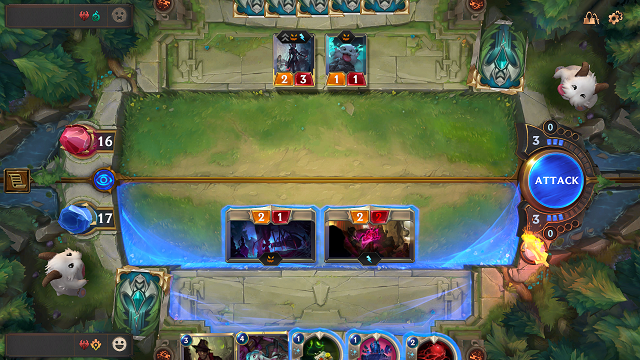Welcome to the second guide in our series of Legends of Runeterra (LoR) guides. To recap: I’ve been playing CCGs for years, but I’ve recently hit Masters on the EUW ladder in Runeterra and want to help the community improve. Now, let’s jump into today’s topic: Open Attack.
Much like my first guide on Initiative, this guide is intended for intermediate players and beginners, but basic knowledge of the game mechanics is useful.
Legends of Runeterra has something colloquially known as Open Attack, which is a pretty uncommon concept in other popular CCGs — again, just like the Initiative system, the closest comparison is actually Yu-Gi-Oh!.
Understanding Open Attack is vital to improving at the game, and it requires some advanced knowledge of LoR’s regions and meta decks, but it’s absolutely invaluable to climbing.
To summarise, briefly: Open Attacking is the action of attacking at the start of your turn, before allowing your opponent the chance to respond to your board.
In many other CCGs, attacking ends your turn, making this a pretty poor option if you have anything else in your hand that you could play.
In LoR, however, you can still spend your mana to summon followers or cast spells after you’ve attacked. This opens up interesting possibilities to outplay your opponent and swing unfavorable matchups in your favor by denying their biggest threats.
Let’s dig in.
Burst vs. Fast vs. Slow

To utilize Open Attack properly, we need to understand the difference between Slow, Fast, and Burst cards.
Burst and Fast are keywords unique to spell cards in LoR. Burst spells can’t be responded to immediately by your opponent, while Fast spells can only be replied to with Fast or Burst spells (within the same interaction).
For the sake of discussing Open Attack, we’ll group these together when describing “Fast-speed threats.”
Slow spells can also be responded to with Fast or Burst spells, but they notably cannot be used during combat. They also cannot be used to respond to one of your opponent’s actions. For this reason, Skills generated from units are also considered as Slow-speed threats.
Do you see where we’re going with this?
You can deny some value of your opponent’s Slow-speed threats by attacking with the first action of your turn — or “Open Attacking”.
A good example of this is Arachnoid Sentry, a card that’s popular in Noxus/Ezreal and Noxus/Spider decks. When facing these decks, summoning a unit before attacking is risky, as your most valuable attackers are likely to be stunned.

In other terms, your opponent is getting a positive trade by stunning one of your potential attackers, while also adding another blocker to the board. This heavily incentivizes you to Open Attack instead of summoning more units at the start of your turn.
Similarly, Avalanche is a Slow spell that also punishes you for developing more units to the board. Figuring out what Slow threats your opponent might have is key to deciding whether you should Open Attack or not.
If we examine Fast threats — such as Statikk Shock or Spirit’s Refuge — these can threaten your gameplan before or during battle. Against decks that run these cards, therefore, it’s often better to summon additional units, as it creates extra threats for your opponent to worry about during combat.
Harsh Winds is a good example of a Burst-speed threat to watch out for against Freljord decks, too.
Other Factors & an Actionable Example

There are, of course, other reasons why Open Attacking may or may not be the ideal play; let’s look at an example.
In the game above, I’m playing Karma/Ezreal against a Karma/Thresh deck. They have 5 mana to spend, which will almost definitely be spent on a blocker if I decide to play more units.
More importantly, however, I have a Chempunk Pickpocket on my field. Pickpocket’s ability to steal spells is incredibly useful, so taking the chance to Open Attack here is always best.
My opponent is likely going to have to play Withering Wail if they want to stop my attack, which is an excellent trade for me as they can’t heal their Nexus above 20, and it would leave me free to develop Karma and start generating free spells without fear of interruption.
The decision of whether or not to Open Attack should also be dictated by how many of their threats have already been used. In the example above, another threat that could stop my attack is Vile Feast.
My opponent had already played one copy of Vile Feast in an earlier turn, though, so playing around the possibility of them having a second copy that early into the game isn’t really worth it.
Vile Feast is also a Fast-speed threat, and Karma/Ezreal isn’t a deck that wants to prioritize early damage, so all signs point towards an Open Attack being the ideal play for that example.
Another key factor to consider is whether you’re ahead of your opponent or behind them in terms of your respective win conditions. This will be the topic of another of our upcoming guides, so be sure to check GameSkinny regularly for more LoR content!










Published: Apr 21, 2020 5:14 PM UTC